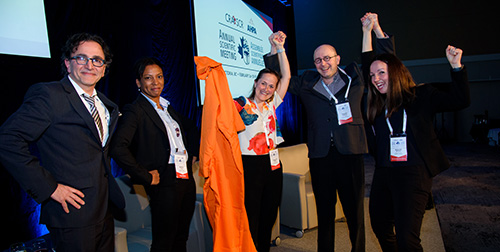Summer 2020 (Volume 30, Number 2)
To Diagnose or Not To Diagnose: Be It Resolved That It Is Better To Under-diagnose Than To Over-diagnose In Rheumatology Practice
By Volodko Bakowsky, MD, on behalf of Corisande Baldwin, MD; Andrea Knight, MD, MSCE; Kam Shojania, MD; and Amanda Steiman, MD, MSc
Download PDF
Those who attended this year’s CRA meeting were on tenterhooks awaiting the outcome of one of the showcase events of the meeting – The Great Debate. This year we had a youthful and enthusiastic group of debaters join crafty, not yet washed up veteran debater Kam Shojania. The collision of the “In Favour” team (Drs. Shojania and Andrea Knight) with the “Against” Team (Drs. Amanda Steiman and Corisande Baldwin) erupted on the stage like two juggernauts.
Dr. Shojania started off with a discussion of cognitive bias, and the Dunning-Kruger Effect. If you do not know what that is, then it assuredly applies to you! There were some deft illustrations of where the two debating sides exist on a graph of confidence vs. wisdom. He then introduced the categories of the diagnostic grid – true positive, true negative, false positive and false negative – prompting the audience to think deeply about the consequences of misdiagnosis. Dr. Shojania finished off by accusing and convicting opposing team member, Dr. Baldwin, of over-diagnosis with the suggestion that she would look fetching wearing an orange jumpsuit.
Dr. Baldwin was first up for the “Against” team. She used her background as a trainee at the University of British Columbia (UBC) to deftly eviscerate Dr. Shojania and attempt to shred his credibility. The first half of her argument outlined all the biases that can contribute to under-diagnosis, and she corrected the myth that over-diagnosis means misdiagnosis. She subsequently illustrated several examples of the harm that can be caused by under-diagnosis – ischemic fingers, saddle nose deformity, arthritis mutilans, to name a few.
Dr. Knight continued where her partner had left off, eliciting the audience’s help in placing several lupus-like cases into the categories of the diagnostic grid. Unsurprisingly true positives and true negatives were uncontroversial. She then illustrated some of the harmful consequences of over-diagnosis (false positives) – unnecessary investigations and treatment, adverse mental health effects, labelling and delay or failure to reach the true diagnosis. This was contrasted to the much lesser harm of delay in lupus diagnosis for serologically active, clinically quiescent cases, which might end up being under-diagnosed. In anticipation of the next speaker, Dr. Knight dug out several quotes from Dr. Steiman, including “I am not sure I am qualified to give advice” (ouch!) that would no doubt anticipate and undermine any argument that would follow.
Last up was Dr. Amanda Steiman who came out punching. She hit the audience with the startling fact that in the United States, 54% of lawsuits were for failure to diagnose and another 20% were for delayed diagnosis. She also offered a final rebuttal to the other side’s position, stating that under-diagnosis was, in fact, a form of misdiagnosis.
It was time for the audience to declare a winner. Without any debate, the audience applause-o-meter clearly determined that the “Against” side were the victors.
In my opinion, however, everyone who attended was actually a winner. We were all treated to an entertaining and spirited event. I want to thank everyone who participated. This year’s debate will be a hard act to follow.

Debaters unwittingly celebrating less than six feet apart from
each other.

Drs. “Orange Jumpsuit” Baldwin and Steiman raise their arms in
victory. Drs. Knight and Shojania each received a “Certificate of
Participation.”
Volodko Bakowsky, MD, FRCPC
Interim Division Head/Chief, Associate Professor,
Division of Rheumatology, Department of Medicine
Dalhousie University, Halifax, Nova Scotia
|
